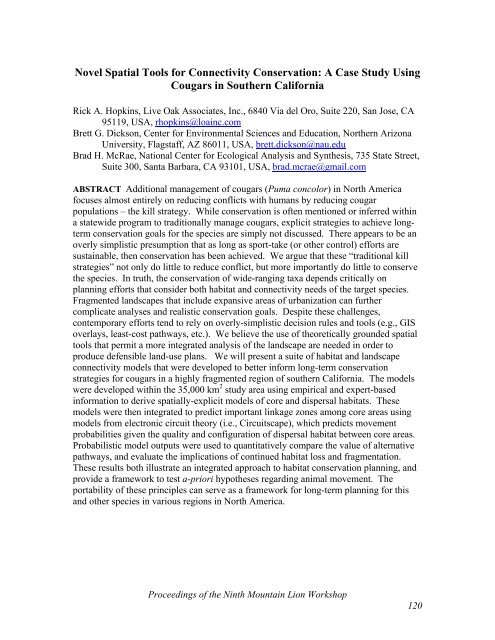Proceedings of the Ninth Mountain Lion Workshop - Carnivore ...
Proceedings of the Ninth Mountain Lion Workshop - Carnivore ...
Proceedings of the Ninth Mountain Lion Workshop - Carnivore ...
You also want an ePaper? Increase the reach of your titles
YUMPU automatically turns print PDFs into web optimized ePapers that Google loves.
Novel Spatial Tools for Connectivity Conservation: A Case Study Using<br />
Cougars in Sou<strong>the</strong>rn California<br />
Rick A. Hopkins, Live Oak Associates, Inc., 6840 Via del Oro, Suite 220, San Jose, CA<br />
95119, USA, rhopkins@loainc.com<br />
Brett G. Dickson, Center for Environmental Sciences and Education, Nor<strong>the</strong>rn Arizona<br />
University, Flagstaff, AZ 86011, USA, brett.dickson@nau.edu<br />
Brad H. McRae, National Center for Ecological Analysis and Syn<strong>the</strong>sis, 735 State Street,<br />
Suite 300, Santa Barbara, CA 93101, USA, brad.mcrae@gmail.com<br />
ABSTRACT Additional management <strong>of</strong> cougars (Puma concolor) in North America<br />
focuses almost entirely on reducing conflicts with humans by reducing cougar<br />
populations – <strong>the</strong> kill strategy. While conservation is <strong>of</strong>ten mentioned or inferred within<br />
a statewide program to traditionally manage cougars, explicit strategies to achieve longterm<br />
conservation goals for <strong>the</strong> species are simply not discussed. There appears to be an<br />
overly simplistic presumption that as long as sport-take (or o<strong>the</strong>r control) efforts are<br />
sustainable, <strong>the</strong>n conservation has been achieved. We argue that <strong>the</strong>se “traditional kill<br />
strategies” not only do little to reduce conflict, but more importantly do little to conserve<br />
<strong>the</strong> species. In truth, <strong>the</strong> conservation <strong>of</strong> wide-ranging taxa depends critically on<br />
planning efforts that consider both habitat and connectivity needs <strong>of</strong> <strong>the</strong> target species.<br />
Fragmented landscapes that include expansive areas <strong>of</strong> urbanization can fur<strong>the</strong>r<br />
complicate analyses and realistic conservation goals. Despite <strong>the</strong>se challenges,<br />
contemporary efforts tend to rely on overly-simplistic decision rules and tools (e.g., GIS<br />
overlays, least-cost pathways, etc.). We believe <strong>the</strong> use <strong>of</strong> <strong>the</strong>oretically grounded spatial<br />
tools that permit a more integrated analysis <strong>of</strong> <strong>the</strong> landscape are needed in order to<br />
produce defensible land-use plans. We will present a suite <strong>of</strong> habitat and landscape<br />
connectivity models that were developed to better inform long-term conservation<br />
strategies for cougars in a highly fragmented region <strong>of</strong> sou<strong>the</strong>rn California. The models<br />
were developed within <strong>the</strong> 35,000 km 2 study area using empirical and expert-based<br />
information to derive spatially-explicit models <strong>of</strong> core and dispersal habitats. These<br />
models were <strong>the</strong>n integrated to predict important linkage zones among core areas using<br />
models from electronic circuit <strong>the</strong>ory (i.e., Circuitscape), which predicts movement<br />
probabilities given <strong>the</strong> quality and configuration <strong>of</strong> dispersal habitat between core areas.<br />
Probabilistic model outputs were used to quantitatively compare <strong>the</strong> value <strong>of</strong> alternative<br />
pathways, and evaluate <strong>the</strong> implications <strong>of</strong> continued habitat loss and fragmentation.<br />
These results both illustrate an integrated approach to habitat conservation planning, and<br />
provide a framework to test a-priori hypo<strong>the</strong>ses regarding animal movement. The<br />
portability <strong>of</strong> <strong>the</strong>se principles can serve as a framework for long-term planning for this<br />
and o<strong>the</strong>r species in various regions in North America.<br />
<strong>Proceedings</strong> <strong>of</strong> <strong>the</strong> <strong>Ninth</strong> <strong>Mountain</strong> <strong>Lion</strong> <strong>Workshop</strong><br />
120
















